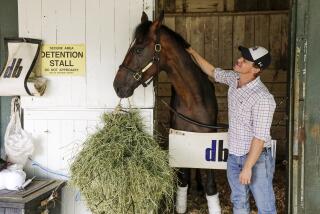Medical Circuit Rider : Veterinarian: Dr. Kirk E. Pollard ranges over a lot of territory in treating all creatures great . . . and even bigger.
YORBA LINDA — Equine veterinarian Kirk E. Pollard was stuck on the San Gabriel River Freeway during the afternoon commute hour as he tried to get from Huntington Beach to Pico Rivera to save a dying horse.
It was the eighth hour of a 12-hour day spent mainly on the road, traveling to routine barn calls in Walnut, Whittier and Huntington Beach. Now Pollard’s Ford pickup truck, stocked with medical supplies and an X-ray machine, was 15 miles from his patient but edging forward at just 20 m.p.h.
“It’s extremely frustrating to be stuck on the freeway when you are trying to get to an emergency,” Pollard said. “My body gets tied in knots, but you have to accept the fate. All it does is make my hair grayer.”
The delay turned out to be irrelevant, however: The horse had suffered a ruptured intestine and from that instant was destined to die within hours.
In Orange County, getting routine or emergency medical treatment for a horse is rarely accomplished with a quick response from a nearby doctor. Equine medicine is the domain of about 20 veterinarians who work out of the back of pickups, visiting most of their patients in stables throughout the county and eastern Los Angeles County.
“To do this job, you have to appreciate the horses and a chance to work outdoors because it is a lot easier to have a small-animal practice,” Pollard said. “You spend a lot of your day in traffic, and the only thing you know about your hours each day is that they are going to be long.”
On a recent Friday, Pollard began his day at 8:30 a.m. at his Equine Veterinary Associates office in Yorba Linda. He is one of three partners in the clinic, which leases part of the Rocking Ranch in a rural part of Yorba Linda.
Jim Tice, the ranch’s owner, had brought in Charlie, a 1-year-old quarter horse whose color is changing from red to gray. The colt was gelded, a 10-minute procedure, in the clinic’s round operating room, which is equipped with a soft cork floor and white padded walls to lessen the chance of injury to horses that get out of control.
Moments after the operation was over, Charlie--who snored as he lay on the floor--began to stir as the anesthetic wore off. Suddenly, the 1,100-pound animal turned two violent somersaults, catapulting off the ground as his powerful legs thrashed the air in a futile attempt to rise.
Pollard shouted for everyone to flee the room while he and an assistant grabbed Charlie and helped him stand, albeit wobbly, for several minutes before they led him to an adjoining stall.
“You have to try not to be afraid of the horses, but you have to respect their strength,” Pollard said later. “It has been a few years since I was last seriously kicked. I don’t want it to happen again.”
By 10 a.m., Pollard was on the road to the Brookside Equestrian Center in Walnut to examine Spreckles, a 23-year-old gray mare who has melanoma, a potentially fatal skin cancer common among light-colored horses.
Exiting the Orange Freeway into a neighborhood of tract homes and strip malls, Pollard turned up a dirt road lined with trees until he reached green rolling hills dotted with hedges and white picket fences.
At the barn, he was greeted by Spreckles’ owner, Glenn Davidson, who owns a crating company.
Spreckles’ illness has been hard on Davidson and his wife because they have owned the horse for 17 years and treated her like the child they never had, Davidson said. They threw a party for Spreckles on her latest birthday, with 100 guests entertained by a clown, a magician and balloons. Spreckles’ treat was a bouquet of carrots.
After examining Spreckles’ sores, Pollard told Davidson that the horse was improving and that they should keep using prescribed salves and medication. Davidson smiled.
Pollard then headed to a ranch where he examined Jesse, a 12-year-old mustang whose owner, Christy House, needed Pollard’s approval before a health insurance company would renew a policy on the horse.
“Like a lot of owners, she knows how she is with that horse, and she knows that it is better to spend a few hundred dollars now for insurance because if that horse gets sick, she’d allow it to drag her down financially,” Pollard said.
For example, surgery and after-care for colic, a common equine digestive disorder, can easily exceed $4,000, he said.
He then gave a clean bill of health to a day-old foal and conducted a routine blood test on a miniature horse. He then reloaded his truck and headed toward Huntington Beach, where Tom Flora waited for Pollard to examine George, a $10,000 Dutch jumper that Flora hoped to buy for his daughter, Katie, 20.
Arriving at the Mike Nielsen Training Stable about 1:30 p.m., Pollard listened to George’s heart, examined his legs and checked his coat. He then took the 6-year-old horse to a riding ring, where an attendant ran George while Pollard watched its gait. Flora, a Huntington Beach electrician, his wife and daughter watched.
Pollard then took X-rays of George’s legs, using a portable machine about the size of a lunch pail. The 90-minute exam cost $480.
“When you are making this large of an investment, the fee is worth it,” Flora said. “It is not only an investment of money, but an investment of emotions. You become very quickly attached to these animals, so it is better to know before you buy the horse whether it is sound.”
Pollard gave George his approval, then visited two other equine patients, cleaning a lacerated hoof on one and checking the limp of another. When he was done, his secretary called him on his car phone with a report of the emergency in Pico Rivera, and Pollard immediately headed north on the San Gabriel River Freeway.
When he finally arrived at the Bicentennial Park Equestrian Center behind the Pico Rivera Sports Arena, Pollard knew that his patient, Glory, was in trouble. Owner Valerie Hippler and a friend were dousing the horse with water outside its stall to lower its temperature, which was 105 degrees instead of a normal 100. The horse’s head was bowed and its lips were loose and droopy.
After a quick examination, Pollard determined that the mare had a ruptured intestine and would die painfully within hours. The only alternative was to put Glory out of her misery.
“I’m really sorry to have to give you that information,” Pollard told Hippler, who looked skyward and began to cry.
Pollard said breaking bad news is the part of his job he dreads: “The worst part for me is the instant that I know the horse is dying, but the owner doesn’t, and I know I have to tell them. In many cases, it is the last thing on their minds that a minute from now they are going to be asked to make a life-or-death decision for their horse.”
Pollard told Hippler that she could stay with Glory while she was put down, but it would not be pleasant, and it might be best if she left. Hippler, tears streaming down her face, hugged her horse and walked away.
Pollard gave Glory the fatal shot, and she died within seconds.
He performed a quick necropsy, pulling three gray stones from the animal’s belly. Called enterolith, the stones form in the intestines over years in about 10% of local horses because of the large amounts of calcium and other chemicals found in local water and feed. Many horses live for years without discomfort from the stones, Pollard said, but some, such as Glory, die from them.
With 115 miles of driving behind him, at 6 p.m. Pollard headed to his final call of the day--three hours of routine dental cleanings and checkups at a Yorba Linda stable. As he drove, he reflected on the last patient.
“The thing that gets me through these situations is that I know what is in store for that animal, and I can stop it painlessly,” Pollard said. “The horse is on a path, and there are no escapes. I can shorten the path.”


